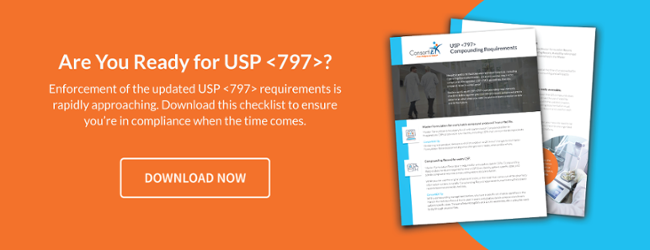
Hospital central fill facilities and individual hospitals will soon need to comply with the updated USP <797> guidelines. While the regulation is not yet in place, it’s important to have a plan in place for your organization. In the event of an accreditation survey or audit, would you be in compliance with the updates today?
Master Formulation Record
As part of the updated USP General Chapter <797>, you must have a Master Formulation Record for every batch compound produced in your facility. This is a new concept and applies for all anticipatory batch Compounded Sterile Preparations (CSPs) produced in your facility, including CSPs that use non-sterile ingredients.
A Master Formulation Record is, essentially, a recipe for creating a CSP inside your pharmacy. It should include ingredients, steps, release inspection procedures, supporting documentation, sterility, and instability reports. In essence, a Master Formulation Record should include everything you need to complete the production of a batch compound.
Get Ready!
Your pharmacists and pharmacy technicians can’t rely on memorizing recipes, and while storing them in binders may technically be compliant, it gets tedious to manage and increases the risk of errors.
Instead, a fully-electronic Master Formulation Record is ideal. This allows pharmacists to easily access and search all of their formulations and track changes to the process while having version control in case of an update made in error.
Compounding Records
Compounding Records will soon be required for everything; every batch compound, every patient-specific dose–everything that is compounded will need a record.
Get Ready!
Many people are using the original physicians’ order or the pharmacy information system label for documentation as this contains most of the necessary information. First, the paper label needs to be stored or retained, then it needs to be filed and must remain easily accessible.
With a compounding management system, you have a specific set of steps identified in the Master Formulation Record that can be used in every batch compound and every patient-specific dose. This eliminates paper documentation and streamlines retention and retrieval.
Sterility & Stability Documentation
The updated USP <797> guidelines will require that sterility and stability documentation be linked to each batch compound. Release testing results are part of the Compounding Record, while sterility and stability documentation is part of the Master Formulation Record.
Get Ready!
Sterility and stability documentation needs to be easily retrievable they should not reside in paper documents, binders, or be spread around a pharmacy. Having an electronic system will ensure paper documents are not misplaced or thrown away.
Beyond Use Dating (BUD) & Release Testing Determination Documentation
USP <71> is dedicated to the testing that is required to release a CSP with an extended BUD. You will have to document the testing procedure as part of the “recipe” or Master Formulation Record.
As part of the updated USP <797> guidelines, sterility testing that documents testing details for each item will be required. Presently, anything under 25 compounds does not require sterility testing, but the new regulation makes this mandatory for every CSP with an extended BUD.
Get Ready!
Like many of the other requirements of this chapter, paper documentation is not the ideal solution. An electronic system ensures all documentation is easily accessible, and clearly organized, for regular use, and easily retrievable.
Enforcement of updated USP <797> requirements is approaching quickly. In the case of an accreditation survey or audit, you will need to produce your documentation to avoid Inspection Observations or Citations. Failure to remediate Inspection Observations or Citations can lead to a facility shutdown.
If you don’t yet have processes in place to comply, it’s time to evaluate your policy and procedures and to start implementing changes today. If you aren’t sure what USP <797> means for you, download our checklist on the updated requirements.

